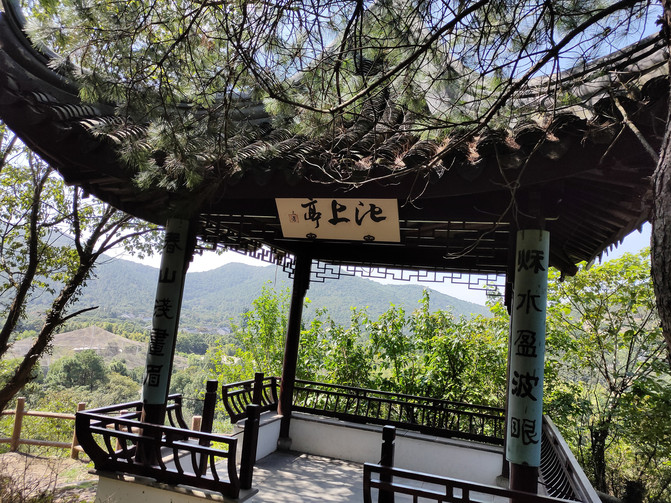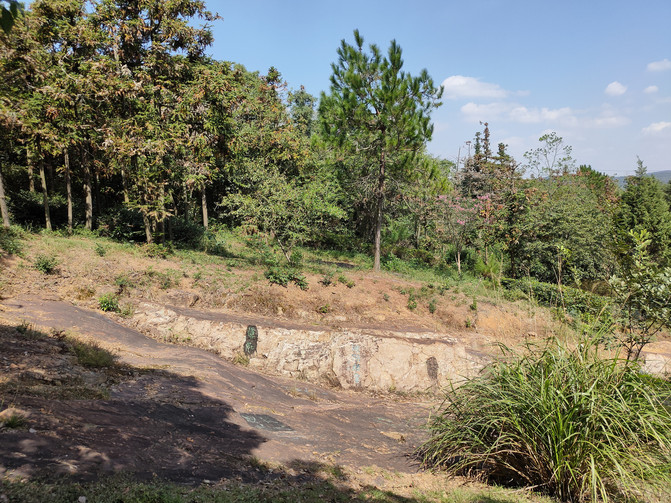Xiaolongzhong, Mr. Li Genyuan's seclusion (Part 2)
★ Tourist location: Xiaolongzhong, Suzhou
Queying Village House has white walls and black tiles, which is a typical Jiangnan dwelling house. The Songhai Painting and Calligraphy Tribe is a group of buildings with closed doors. It looks like a business place such as a teahouse and restaurant.
Wufeng Pavilion is a rectangular pavilion, somewhat like an open pavilion. There are couplets on the pillars on both sides, and poplar and other plants are planted around it. When Li Genyuan lived in seclusion here, he planted tens of thousands of pine trees, so the green coverage rate of Xiaowang Mountain is quite high.
There is a group of Ming and Qing Dynasties buildings next to it. The gate doesn't look big. Only when you walk in, you realize that there is something else. Behind a landscape screen is the hall, with palace lanterns hanging from the ceiling, bright red tassels, and Chinese furniture full of the house. Under the plaque of "Huaidetang" is a vertical axis painting, and there are couplets on both sides. It is a typical Jiangnan folk house. Of course, this residential house is also a family with a certain status, not just a casual ordinary citizen. It is not so grand. After all, economic strength does not allow it.
There are some cultural relics on display in the former residence. I wonder if they are old things belonging to Mr. Li Genyuan. If so, you may love collecting and collect many good things.
The building complex along the doorway is of a unified style. I wonder if it was rebuilt later. One of them has a "full use of literature and history" room. The room is a little empty, but there are wood carvings hanging on the walls, all of which are famous stories in history.
There is a two-story wooden structure house with a "Xing Shan Hall" hanging in the hall, which is also a layout of vertical mountains and rivers and couplets. There is a pair of vases on the long stage, a small square table and two wooden chairs with backs. It is very simple furnishings.
On the second floor is the calligraphy and painting art museum of Xingshan Hall, which displays some calligraphy and painting works. These characters are so beautifully written that although they are not completely unrecognizable, they are still a little difficult to appreciate. There are quite a lot of works, and they are arranged in the corridors and rooms, and they are still full.
This building looks like a courtyard house. Although the hall is not large, the patio is very large, so the lighting is particularly good. The railings on the second floor are all carved with flowers. The patterns are not complicated, but they feel classical and generous. The lacquer uses the true color of wood grain, not vermilion like the houses seen in front. It looks like these houses are more elegant.
Behind it is an archway for the Festival of Loyalty, Filial Piety and Integrity, with exquisite carvings on the stigma and the upper end of the archway. The archway is not big, only having the appearance of a single bay.
Behind the archway is the Temple of Loyalty and Pieces, with two fairly large mahogany screens inscribed with the yellow words "loyalty" and "filial piety". On the other side is a carved mahogany screen flower with the words "Loyalty and filial piety pass long distances."
Xiaowang Mountain is about 400 meters long from north to south and about 300 meters wide from east to west. The whole mountain is really not big. The top of the mountain is round and has a gentle slope. Walk slowly along the road. There are some cliff stone carvings along the road. Among them, one of the relatively slow rocks is carved with the tomb of Que Ying, but looking around, there seems to be no tomb.
Wisteria Gallery was planted in the 1980s by the descendants of Li Genyuan in order to remember their ancestors. Later, the Qionglong Mountain Management Committee rebuilt the corridor and is now an excellent resting place.
There is a Wansong Pavilion behind the corridor. It seems that the pavilion in Xiaolongzhong is bigger than other places. The rectangular pavilion looks very open. Nestled among dense forests, this is also an excellent place to rest.
Hushan Hall is located on a relatively gentle place on the top of the mountain, but the door is locked, so I don't know what it looks like inside. There is a huge stone in front of the house with the word "Pine Sea" engraved on it. At that time, Li Genyuan planted tens of thousands of pine trees, worthy of the titles "Wansong" and "Songhai".
Looking in through the glass window, the couplets inside vaguely show that this was a place to study. Reading on the top of the mountain is really quiet.
Walking towards the back of the mountain, there is a small pavilion. The style of this pavilion is similar to that of most pavilions. The small pavilion at the corner is called the "Tingsong Pavilion". We looked around and were indeed surrounded by tall pine trees. If there is wind, you can indeed hear the rustling of pine trees.
There is also a larger square pavilion, which is also in the pine forest, but at the edge of the mountain, you can enjoy the surrounding scenery here. The continuous mountain range behind is Qionglong Mountain.
We didn't want to go back and go down the mountain. There were more cliff stone carvings here, some of which were very large, dozens of centimeters square. Some are very small, not much larger than broad beans.
"Pang's mother is virtuous, the mountains are not vast, and the soil is inhabited by thousands of years" was inscribed by Song Liankui. His ancestral home was in Yunnan and he is considered a fellow villager with Li Genyuan. However, he was born in the Song Family Garden in Chang 'an, Shaanxi Province. He was successful in the rural examination and later studied at Xi'an Guanzhong College.
"The Tomb of Li Tai's Mother in Tengchong" was inscribed by Wu Changshuo, who was quite famous. He was a famous painter and calligrapher in the late Qing Dynasty and the first president of Hangzhou Xileng Printing Society.
"Qionglong Xiaowangshan" was inscribed by Chen Xiaohu, also a native of Yunnan, a member of the first House of Representatives of the National Assembly and a confidential secretary to Zhu Peide.
Zheng Xiaoxu, the inscription of "Li's Tomb in Tengchong", was a bureaucrat in the late Qing Dynasty, prime minister of the puppet Manchukuo State, a banner man in Minhou County, Fujian Province, and a former consul of Kobe, China.
It is said that there are a total of 106 inscriptions on the cliff by modern celebrities here, 45 inscriptions on the stele corridors, and 23 inscriptions on the stone tablets, totaling 174 cubes. They are all calligraphy treasures left by a collection of political figures and social celebrities of the Republic of China after Mr. Li Genyuan lived here. It can be seen that Li Genyuan's social status at that time was quite high and his friends were quite extensive. Of course, looking back on Mr. Li's magnificent life and the major historical events he participated in, I feel that this is taken for granted.
On the way back, I accidentally found the tomb of Que Ying on the roadside. The cemetery was very large, with the inscription "Tomb of Li Mu Que's wife". The surroundings are built with stones to form a circle. Although the surrounding area is densely covered with trees, the cemetery is clean and tidy. It seems that the staff in the scenic area are diligent in cleaning.
Li Genyuan's tomb is in the dense forest not far away, which is larger than the tomb of Mrs. Que. The seal body used in the tomb is a joint burial tomb for the couple.
Warm reminder: The ten scenic spots of Songhai created by Mr. Li Genyuan include Wansong Pavilion, Tingsong Pavilion, Tingquan Stone, Chui Green Peak, Xiaolongzhong, Woshiwo, Xiaojingtai, Hushan Hall, Liyunjian, and Lingchi. We visited for three hours, but we still couldn't find all ten scenic spots. I don't know where I missed them. Therefore, if you want to visit Xiaolongzhong without missing any attractions, you still need to reserve more time.




















Previous Article:Suzhou, a wetland park praised by the United Nations, has become an ink painting in early spring
